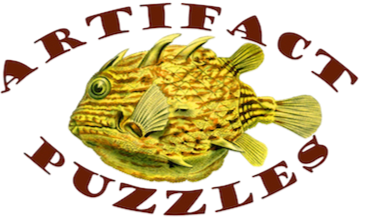
We've just released our first puzzle with imagery created by an artificial intelligence program,
Animals In Motion, "painted" by DALL-E, an AI program trained on just about every image digitized, as well as captions for that image. Back 10 years ago, AI researchers used datasets like that to predict captions for images. Recent advances use similar (but bigger) datasets to flip the problem: Given a caption, like "unicorn on a skateboard", can the AI predict a good image to match the caption?
The answer is "Definitely, sometimes." It can take some iterating and inspired writing of your caption (aka "prompt engineering" to get good images out of this first generation of AI painters.
Our Animals in Motion puzzle has 9 pretty interesting images created by the DALL-E AI:

You can read more about the AI behind that on Jim's substack blog.
Each of the 9 images is its own mini-puzzle of 25 pieces, but we've mixed up all 225 pieces to make this a bit harder, it's still on the easy side for our puzzles though.
Matt Lyon (a real human, not an AI) designed the puzzle pieces. He went for a squiggly curvy feel, with cute whimsies on the theme animals-in-motion. This has some of our most unique whimsies ever, like this duck skate-boarding:
We are working on a second AI painted puzzle for the holidays - we expect to have that in-stock by mid-November.
We are excited to take advantage of AI imagery to augment our puzzle portfolio, but we also continue to actively seek and license a wide variety of human created artwork that we think will make great puzzles. In fact, just this year we've commissioned brand new artwork from artists including Aaron Wolf, Joe Vaux, and Amariah Rauscher, Gordon Barker, Nadieh Bremer, and Valentin Rekunenko.
How are artists feeling about these new AI image painting programs? We interviewed artist Matt Lyon, who is one of the world's leading vector graphics artists and designed the puzzle for Animals in Motion:
Matt: I made use of DALL-E to develop ideas for the whimsy pieces. Inspired by the puzzle designs, I chose a selection of word prompts to generate a variety of images. These were then used to inform the final designs
Q2: As an artist, do you feel DALL-E is a helpful tool?
Matt: DALL-E has the potential to be a helpful tool, but as with many new technologies, it’s very early in its development and has a long way to go until its uses are more controlled and refined. The current results of the image generation can at times feel scattershot, and the quality of their finish often needs refining. Ultimately, I think all AI technologies should be regarded as tools to support or streamline processes, as a means of problem-solving or as an aid to creativity
Q3: As an artist, what do you think of DALL-E's artistry?
Matt: I don’t think DALL-E has any artistry as such, but rather an objective output. At best, the imagery appears derivative as it tries to mimic an artist’s work or collective style. Stylistically, a lot of AI imagery appears quite similar, both in its rendering and finish. And ultimately, I’d best describe those using AI as their only means to generate work as directors or curators rather than artists
Q4: How do you think AI image-generating tools like DALL-E will change the commercial art world?
Matt: There is a lot of potential for AI tools to benefit the creative process, though it could also be equally damaging if copyright law and legislation don’t keep up with the technology. I’m suspicious and cautious of anything described as a ‘disruptive technology’ because the development race can easily overlook its impact, especially if people’s lives or livelihoods are detrimentally affected. Tools should benefit everyone, and ideally, DALL-E and all AI technologies will develop under stringent control with a central awareness of ethics

